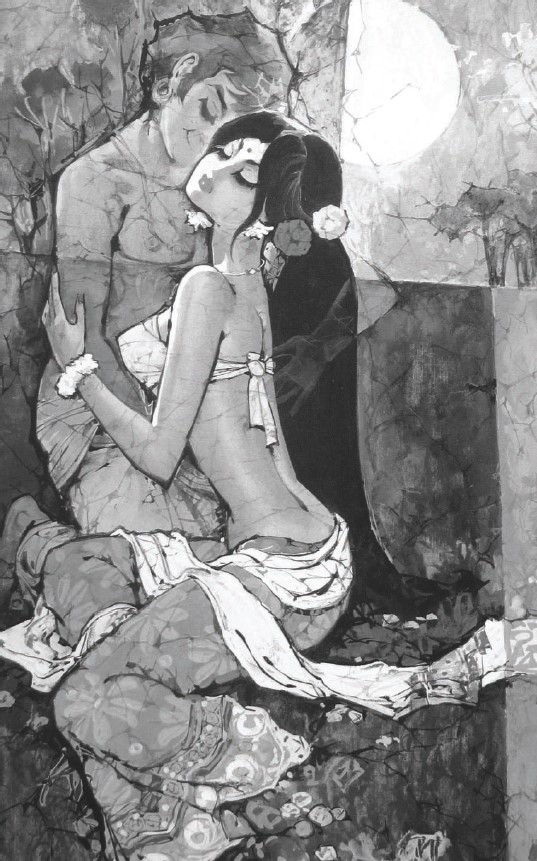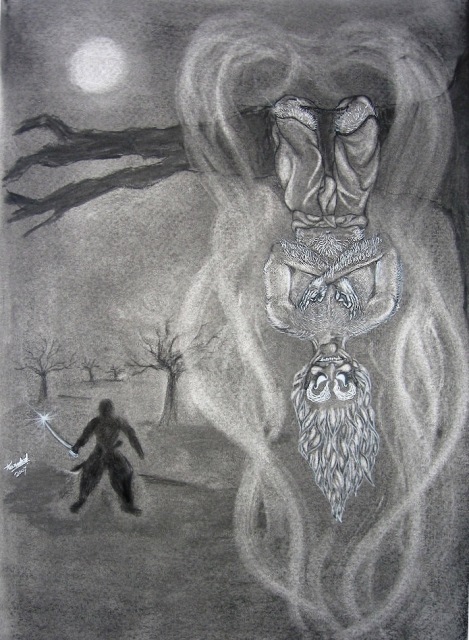|
Bhavabhuti
Bhavabhūti (Devanagari: भवभूति) was an 8th-century scholar of India noted for his plays and poetry, written in Sanskrit. His plays are considered the equal of the works of Kalidasa. Bhavabhuti was born in Padmapura, Vidarbha, in Gondia district, on Maharashtra and Madhya Pradesh border. He is described as an 'Udumbara Brahmin'. His real name was ''Srikantha Nilakantha'', and he was the son of Nilakantha and Jatukarni. He received his education at 'Padmapawaya', a place some 42 km South-West of Gwalior. Dayananidhi Paramahansa is known to be his guru. He composed his historical plays at 'Kalpi', a place on banks of river Yamuna. He is believed to have been the court poet of king Yashovarman of Kannauj. Kalhana, the 12th-century historian, places him in the entourage of the king, who was defeated by Lalitaditya Muktapida, king of Kashmir, in 736 AD. Malatimadhava The play is set in the city of Padmavati. The king desires that his minister's daughter Malati marry ... [...More Info...] [...Related Items...] OR: [Wikipedia] [Google] [Baidu] |
Mahaviracharita
''Mahaviracharita'' ("Exploits of a Great Hero") is a play by the 8th-century Sanskrit playwright Bhavabhuti based on the early life of Rama, the hero of the ''Ramayana'' and venerated as a Hindu deity. It is the first play of Bhavabhuti,Mirashi p.111 thus lacking in character and style compared to his two known later works: '' Malatimadhava'' and '' Uttararamacharita''. Though currently composed of seven acts, the whole present text may not have been composed by Bhavabhuti. Structure and plot The play is composed of seven acts. Most modern scholars agree that Bhavabhuti has written the play from the beginning only to the 46th verse of Act V. According to one theory, the rest of the play is lost to time. Another theory suggests that Bhavabuti left the play incomplete after the 46th verse of Act V. However, two different extensions replace the lost material to make up seven acts. The North Indian version is composed by a poet Vinayaka and the South Indian version is attributed to Su ... [...More Info...] [...Related Items...] OR: [Wikipedia] [Google] [Baidu] |
Uttararamacarita
''Uttararāmacarita'' ( sa, उत्तररामचरित, IAST: Uttararāmacarita) () is a Sanskrit play in seven acts in the ''Nataka'' style by Bhavabhuti. It depicts the later life of Hindu god Rama, from the coronation after Rama's return from exile, to his reunion with his wife Sita whom he abandoned immediately after his coronation and his two sons Lava and Kusha, covering a period of more than twelve years. Characters Main characters: * Ramathe eldest son of King Dasharatha * SitaRama's wife * LakshmanaRama's brother * Atreyian elderly ascetic * Vasantithe sylvan deity Plot Composed in seven acts, Uttararāmacarita's main theme is Sita's abandonment. The first act gives a brief summary of Rama's story up to the fire-ordeal of Sita. The common people who were away from the scene of the fire-ordeal, refused to be convinced, and made uncharitable criticism of Rama's acceptance of Sita. This forced Rama to take the regrettable decision of abandoning her. He sends her a ... [...More Info...] [...Related Items...] OR: [Wikipedia] [Google] [Baidu] |
Yashovarman
Yashovarman (IAST: Yaśovarman) was a medieval Indian ruler of Kannauj, who founded the Varman dynasty of Kannauj. There are few sources that provide information of his life, although he was indubitably a powerful man. Life Yashovarman was king of Kannauj in the early part of the eighth century. The city (then known as Kanyakubja) had previously been ruled by Harsha, who died without an heir and thus created a power vacuum. This lasted for around a century before Yashovarman emerged as its ruler. Alexander Cunningham, an archaeologist of the British Raj period, speculated on possible rulers of Kannauj during the period between Harsha and Yashovarman but there is little evidence to support his claims. Little is known of Yashovarman or his family, with most information being derived from the ''Gaudavaho'' (''Slaying of the king of Gauda''), a Prakrit-language poem written by Vakpati. Yashovarman was a supporter of culture and Vakpati was among his courtiers: the extent to whic ... [...More Info...] [...Related Items...] OR: [Wikipedia] [Google] [Baidu] |
Harvard Oriental Series
The ''Harvard Oriental Series'' is a book series founded in 1891 by Charles Rockwell Lanman and Henry Clarke Warren. Lanman served as its inaugural editor (1891-1934) for the first 37 volumes. Other editors of the series include Walter Eugene Clark (1934-1950, volumes 38–44), Daniel Henry Holmes Ingalls (1950-1983, volumes 45–48) and Gary Tubb (1983-1990, volume 49). Currently in its 93rd volume, the series is edited by Michael Witzel, the Wales Professor of Sanskrit in the Department of Sanskrit and Indian Studies at Harvard University, and distributed by the Harvard University Press. A subseries, ''Harvard Oriental Series Opera Minora'', "aims at the swift publication of important materials that cannot be included in the mainly text-oriented Harvard Oriental Series." Volumes of Main Series Volumes of ''Opera Minora'' subseries See also *Columbia University Indo-Iranian Series *Loeb Classical Library *Murty Classical Library of India The Murty Classical Library of India ... [...More Info...] [...Related Items...] OR: [Wikipedia] [Google] [Baidu] |
Kalidasa
Kālidāsa (''fl.'' 4th–5th century CE) was a Classical Sanskrit author who is often considered ancient India's greatest poet and playwright. His plays and poetry are primarily based on the Vedas, the Rāmāyaṇa, the Mahābhārata and the Purāṇas. His surviving works consist of three plays, two epic poems and two shorter poems. Much about his life is unknown except what can be inferred from his poetry and plays. His works cannot be dated with precision, but they were most likely authored before the 5th century CE. Early life Scholars have speculated that Kālidāsa may have lived near the Himalayas, in the vicinity of Ujjain, and in Kalinga. This hypothesis is based on Kālidāsa's detailed description of the Himalayas in his ''Kumārasambhava'', the display of his love for Ujjain in ''Meghadūta'', and his highly eulogistic descriptions of Kalingan emperor Hemāngada in '' Raghuvaṃśa'' (sixth ''sarga''). Lakshmi Dhar Kalla (1891–1953), a Sanskrit scholar a ... [...More Info...] [...Related Items...] OR: [Wikipedia] [Google] [Baidu] |
Lalitaditya Muktapida
Lalitaditya alias Muktapida (IAST: Lalitāditya Muktāpīḍa; r. c. 724 CE–760 CE) was a powerful ruler of the Karkota dynasty of Kashmir region in the Indian subcontinent. The 12th-century chronicler Kalhana characterizes Lalitaditya as a world conqueror, crediting him with extensive conquests and miraculous powers in his ''Rajatarangini''. According to Kalhana, Lalitaditya defeated the central Indian king Yashovarman, and then marched to eastern and southern parts of India. He subjugated several more rulers on his way back to Kashmir, and then subdued several northern kings. Based on a reconstruction of Kalhana's account, art historian Hermann Goetz (1969) theorized that Lalitaditya managed to create a short-lived empire that included major parts of India as well as present-day Afghanistan and Central Asia. Goetz' analysis was accepted and cited widely by subsequent authors writing on the history of Kashmir. However, Kalhana's account is not supported by the records of Lali ... [...More Info...] [...Related Items...] OR: [Wikipedia] [Google] [Baidu] |
Devanagari
Devanagari ( ; , , Sanskrit pronunciation: ), also called Nagari (),Kathleen Kuiper (2010), The Culture of India, New York: The Rosen Publishing Group, , page 83 is a left-to-right abugida (a type of segmental Writing systems#Segmental systems: alphabets, writing system), based on the ancient Brahmi script, ''Brāhmī'' script, used in the northern Indian subcontinent. It was developed and in regular use by the 7th century CE. The Devanagari script, composed of 47 primary characters, including 14 vowels and 33 consonants, is the fourth most widely List of writing systems by adoption, adopted writing system in the world, being used for over 120 languages.Devanagari (Nagari) , Script Features and Description, SIL International (2013), United States The orthography of this script reflects the pr ... [...More Info...] [...Related Items...] OR: [Wikipedia] [Google] [Baidu] |
Rama
Rama (; ), Ram, Raman or Ramar, also known as Ramachandra (; , ), is a major deity in Hinduism. He is the seventh and one of the most popular '' avatars'' of Vishnu. In Rama-centric traditions of Hinduism, he is considered the Supreme Being. Rama is said to have been born to Kaushalya and Dasharatha in Ayodhya, the ruler of the Kingdom of Kosala. His siblings included Lakshmana, Bharata, and Shatrughna. He married Sita. Though born in a royal family, their life is described in the Hindu texts as one challenged by unexpected changes such as an exile into impoverished and difficult circumstances, ethical questions and moral dilemmas. Of all their travails, the most notable is the kidnapping of Sita by demon-king Ravana, followed by the determined and epic efforts of Rama and Lakshmana to gain her freedom and destroy the evil Ravana against great odds. The entire life story of Rama, Sita and their companions allegorically discusses duties, rights and social responsibil ... [...More Info...] [...Related Items...] OR: [Wikipedia] [Google] [Baidu] |
Sita
Sita (; ) also called as Janaki and Vaidehi is a Hindu goddess and the female protagonist of the Hindu epic, ''Ramayana''. She is the consort of Rama, the avatar of the god Vishnu, and is regarded as a form of Vishnu's consort, Lakshmi. She is also the chief goddess of Rama-centric Hindu traditions. Sita is known for her dedication, self-sacrifice, courage, and purity. She is one of the seventeen national heroes (r''astriya bibhuti'') of Nepal. Described as the daughter of Bhūmi (the earth), Sita is brought up as the adopted daughter of King Janaka of Videha. Sita, in her youth, chooses Rama, the prince of Ayodhya as her husband in a swayamvara. After the swayamvara, she accompanies her husband to his kingdom, but later chooses to accompany her husband, along with her brother-in-law Lakshmana, in his exile. While in exile, the trio settles in the Dandaka forest from where she is abducted by Ravana, the Rakshasa king of Lanka. She is imprisoned in the garden of Ashoka Vatik ... [...More Info...] [...Related Items...] OR: [Wikipedia] [Google] [Baidu] |
Baital Pachisi
''Vetala Panchavimshati'' ( sa, वेतालपञ्चविंशति, IAST: ) or ''Betaal Pachisi'' ("''Twenty-five (tales) of Betaal''"), is a collection of tales and legends within a frame story, from India. It is also known as internationally Vikram-Betaal. It was originally written in Sanskrit. One of its oldest recensions is found in the 12th Book of the ''Kathasaritsagara'' ("Ocean of the Streams of Story"), a work in Sanskrit compiled in the 11th century by Somadeva, but based on yet older materials, now lost. This recension comprises in fact twenty-four tales, the frame narrative itself being the twenty-fifth. The two other major recensions in Sanskrit are those by Śivadāsa and Jambhaladatta. The Vetala stories are popular in India and have been translated into many Indian vernaculars. Several English translations exist, based on Sanskrit recensions and on Hindi, Tamil, Bengali and Marathi versions. Probably the best-known English version is that of Sir Richa ... [...More Info...] [...Related Items...] OR: [Wikipedia] [Google] [Baidu] |
Vetala
A vetala ( sa, वेताल ') or Betal is a Bhairava form of Shiva in Hindu mythology, usually defined as a knowledgeable (fortune telling) paranormal entity said to be dwelling at charnel grounds. The vetala is comparable to the vampires of Western mythology. Reanimated corpses are used as vehicles by the spirits for movement, the corpse no longer decays while it is inhabited by a ''vetala''. A vetala may possess and also leave a dead body at will. Description In Hindu folklore, the vetala is an evil spirit who haunts cemeteries and takes demonic possession of corpses. They make their displeasure known by troubling humans. They can drive people mad, kill children, and cause miscarriages, but also guard villages. They are hostile spirits of the dead trapped in the 'twilight zone' between life and afterlife. These creatures can be repelled by the chanting of mantras. One can free them from their ghostly existence by performing their funerary rites. Being unaffected by the laws ... [...More Info...] [...Related Items...] OR: [Wikipedia] [Google] [Baidu] |


.jpg)



_Illustrated_by_Ernest_Griset_page048.png)
